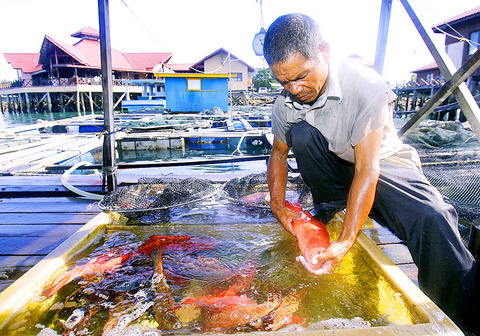The rising demand for live reef fish by seafood-hungry diners in China and Taiwan has for the first time been shown to have severely depleted numbers of endangered species around Asia, a study released yesterday said.
Researchers studying the trade in Malaysia, formerly home to some of Asia's most abundant coastal reefs, found that catches of some grouper species and the Napoleon wrasse fell by as much as 99 percent between 1995 and 2003, a period coinciding with the rapid economic growth of countries where such exotic fish are a delicacy.
"The removal of these large, predatory fish might upset the delicate balance of the coral reef ecosystem," said Helen Scales, who co-authored the study for the Swiss-based World Conservation Union (WCU), appearing in the online edition of Proceedings of The Royal Societies, a respected scientific journal.

PHOTO: AP
"With all the threats the reefs already face, these fishing practices take us one step closer to losing these reefs," Scales said.
The study of daily fish catches and sales quantifies what many conservationists have said for a decade -- that hunger for live reef fish in Hong Kong, Taiwan and China is causing populations of wrasse, grouper and coral trout on coastal reefs to plummet in Malaysia, Indonesia, the Philippines and Papua New Guinea.
The UN and the WCU released a report last year warning that human exploitation of the high seas was putting many of its resources on the verge of extinction.
It noted that 52 percent of global fish stocks are over harvested and that populations of the largest fish such as tuna, cod and swordfish declined as much as 90 percent in the past century.
It also said destructive fishing practices -- including bottom trawling, illegal longline fishing and a rise in large industrial vessels -- have led to the deaths of tens of thousands of seabirds, turtles and other marine life.
"Well over 60 percent of the marine world and its rich diversity found beyond the limits of national jurisdiction is vulnerable and at increasing risk," Ibrahim Thaiw of the WCU said in a statement last year.
Reef fish -- which are caught mostly by small fishermen who sometimes use cyanide to stun their catch -- are prized mostly because they are cooked live. Traders are careful to ensure they arrive that way, packaging them in bags of water and placing them in white coolers for a trip that often takes them thousands of kilometers to seafood restaurants that resemble aquariums.
Diners stroll past bubbling tanks stuffed full of fish that can cost as much as US$100 a kilogram.
"Most Hong Kong people now choose to eat grouper because of the firm flesh. It's tastier," said Ng Wai Lun, a restaurant owner in Hong Kong, which consumes the most reef fish of any city.
"Farmed fish is less tasty and fresh," he said.
Some go closer to the source. Kerry To, a Hong Kong resident, flew to Malaysia for a holiday to enjoy a meal of steamed grouper in Kota Kinabalu, a few hours away from key reef fishing grounds.
"These fish are so big and taste so good. I'll be telling my friends," said To, 45, tucking into a meal of steamed fish with a dozen other Hong Kong tourists.
Annadel Cabanban of the World Wide Fund for Nature, who studies the trade in Malaysia, agreed with the study's finding that the numbers of reef fish were on the decline due to increasing human demand within Asia.
She said destructive fishing practices -- namely explosives and the use of cyanide over the past 10 years -- were as much to blame for the decline as overfishing because they destroy crucial reef habitats, affecting reproduction.
"There are no predators to check the fish that eat the plants and the shellfish," Cabanban said.
"There is a cascading effect on the reef. With so many herbivores, the plant population declines and fish run out of food and they die," she said.
Scales, the study's co-author, said it was impossible to quantify how many fish were taken by explosives or cyanide because fishermen refuse to discuss it.
Conservationists fear that the growing demand for live fish -- an industry worth more than US$1 billion a year -- is adding pressure to coral reefs already threatened by warming oceans, development and pollution.
Some 88 percent of Southeast Asia's coral reefs face destruction from overfishing and pollution, the US-based World Resources Institute estimates. Most under threat were the Philippines and Indonesia, home to 77 percent of the region's nearly 100,000km2 of reefs.
Fishermen in Kudat -- a sleepy South China Sea port in Malaysia that depends almost entirely on fishing -- acknowledged that catches have declined. Their boats now travel to the neighboring Philippines to find prized reef fish.
The fishermen argue that there are plenty of fish and that they have few options.
"This is our livelihood," said Ismail Noor, 45, adding that he sometimes spends three days at sea in search of the fish.
"If we stop, we would have no income," he said.
Noor and his fellow fishermen insist they use only hooks and lines or nets. But the local fisheries department said the use of explosives remains widespread, despite campaigns that warn of the dangers of losing arms, legs and hands.
"Most villagers are stubborn and have always done bombing since they were children," said fisheries official A. Hamid Maulana.
"It is difficult to change attitudes," he said.
Conservationists say the answer is to establish international standards for managing the import and export of reef fish, and consumers must be educated about the need to avoid certain endangered fish.

FRUSTRATIONS: One in seven youths in China and Indonesia are unemployed, and many in the region are stuck in low-productivity jobs, the World Bank said Young people across Asia are struggling to find good jobs, with many stuck in low-productivity work that the World Bank said could strain social stability as frustrations fuel a global wave of youth-led protests. The bank highlighted a persistent gap between younger and more experienced workers across several Asian economies in a regional economic update released yesterday, noting that one in seven young people in China and Indonesia are unemployed. The share of people now vulnerable to falling into poverty is now larger than the middle class in most countries, it said. “The employment rate is generally high, but the young struggle to

STEPPING UP: Diminished US polar science presence mean opportunities for the UK and other countries, although China or Russia might also fill that gap, a researcher said The UK’s flagship polar research vessel is to head to Antarctica next week to help advance dozens of climate change-linked science projects, as Western nations spearhead studies there while the US withdraws. The RRS Sir David Attenborough, a state-of-the-art ship named after the renowned British naturalist, would aid research on everything from “hunting underwater tsunamis” to tracking glacier melt and whale populations. Operated by the British Antarctic Survey (BAS), the country’s polar research institute, the 15,000-tonne icebreaker — boasting a helipad, and various laboratories and gadgetry — is pivotal to the UK’s efforts to assess climate change’s impact there. “The saying goes

ENERGY SHIFT: A report by Ember suggests it is possible for the world to wean off polluting sources of power, such as coal and gas, even as demand for electricity surges Worldwide solar and wind power generation has outpaced electricity demand this year, and for the first time on record, renewable energies combined generated more power than coal, a new analysis said. Global solar generation grew by a record 31 percent in the first half of the year, while wind generation grew 7.7 percent, according to the report by the energy think tank Ember, which was released after midnight yesterday. Solar and wind generation combined grew by more than 400 terawatt hours, which was more than the increase in overall global demand during the same period, it said. The findings suggest it is

TICKING CLOCK: A path to a budget agreement was still possible, the president’s office said, as a debate on reversing an increase of the pension age carries on French President Emmanuel Macron yesterday was racing to find a new prime minister within a two-day deadline after the resignation of outgoing French Prime Minister Sebastien Lecornu tipped the country deeper into political crisis. The presidency late on Wednesday said that Macron would name a new prime minister within 48 hours, indicating that the appointment would come by this evening at the latest. Lecornu told French television in an interview that he expected a new prime minister to be named — rather than early legislative elections or Macron’s resignation — to resolve the crisis. The developments were the latest twists in three tumultuous